The Impact of Fractal Dimension, Stress Tensors, and Earthquake Probabilities on Seismotectonic Characterisation in the Red Sea
Abstract
:1. Introduction
2. Regional Tectonics of the Red Sea
3. Red Sea Seismicity
3.1. Historical Seismicity
3.2. Instrumental Seismicity
4. Dataset and Methods
5. Analysis of Earthquake Data
GR Relationship: Mc and b-Value
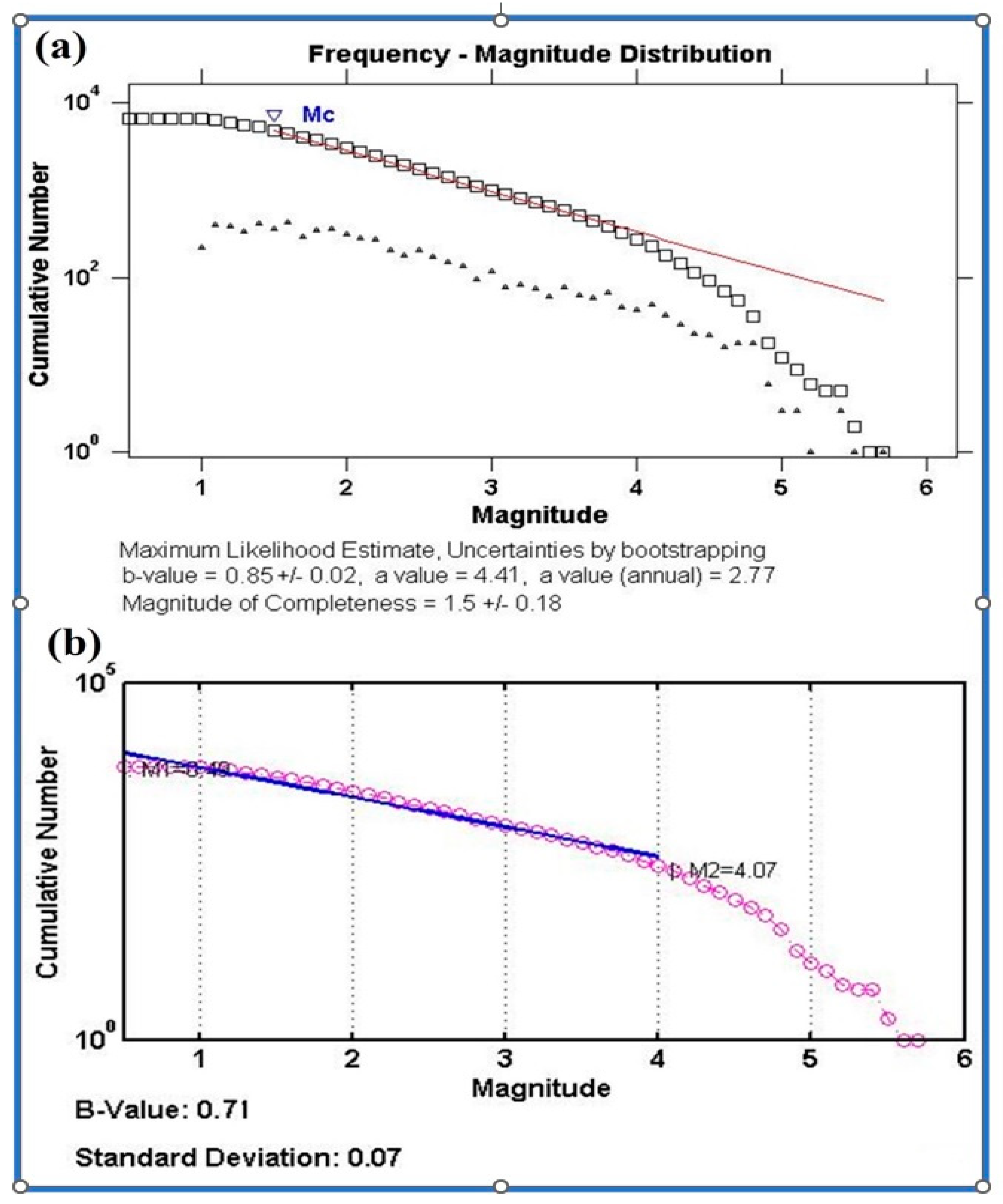

6. Fractal Dimension
7. Focal Mechanisms and Stress Analyses
7.1. Michael’s Stress Tensor Analysis
7.2. Distributions of Pressure and Tension (P-T) Axes and Rake
8. Probabilities of Earthquakes and Return Periods
9. Discussion and Conclusions
Author Contributions
Funding
Data Availability Statement
Acknowledgments
Conflicts of Interest
Disclaimer
References
- El-Isa, Z.H. Seismicity and seismotectonics of the Red Sea Region. Arab. J. Geosci. 2015, 8, 8505–8525. [Google Scholar] [CrossRef]
- Swolfs, H.S. The Triangular Stress Diagram a Graphical Representation of Crustal Stress Measurements; Geological Survey Professional Paper, 1291; United States Government Printing Office: Washington, DC, USA, 1984; p. 19. [Google Scholar]
- Fröhlich, C. Triangle diagrams: Ternary graphs to display similarity and diversity of earthquake focal mechanisms. Phys. Earth Planet. Inter. 1992, 75, 193–198. [Google Scholar] [CrossRef]
- Wiemer, S. A software package to analyze seismicity: ZMAP. Seismol. Res. Lett. 2001, 72, 373–382. [Google Scholar] [CrossRef]
- Michael, A. Use of focal mechanisms to determine stress: A control study. J. Geophys. Res. 1987, 92, 357–369. [Google Scholar] [CrossRef]
- Grassberger, P.; Procaccia, I. Measuring the strangeness of strange attractors. Phys. D 1983, 9, 189–208. [Google Scholar] [CrossRef]
- Bosworth, W.; Huchon, P.; McClay, K. The Red Sea and Gulf of Aden basins. J. Afr. Earth Sci. 2005, 43, 334–378. [Google Scholar] [CrossRef]
- Bonatti, E. Punctiform initiation of seafloor spreading in the Red Sea during the transition from a continental to an oceanic rift. Nature 1985, 316, 33–37. [Google Scholar] [CrossRef]
- Stern, R.J.; Johnson, P.J. Constraining the Opening of the Red Sea: Evidence from the Neoproterozoic Margins and Cenozoic Magmatism for a Volcanic Rifted Margin. In Geological Setting Palaeoenvironment and Archaeology of the Red Sea; Springer: Cham, Switzerland, 2019. [Google Scholar] [CrossRef]
- Cochran, J.R.; Martinez, F. Evidence from the nothern Red Sea on the transition from continental to oceanic rifting. Tectonophysics 1989, 153, 25–53. [Google Scholar] [CrossRef]
- ArRajehi, A.; McClusky, S.; Reilinger, R.; Daoud, M.; Alchalbi, A.; Ergintav, S.; Gomez, F.; Sholan, J.; Bou-Rabee, F.; Ogubazghi, G.; et al. Geodetic constraints on present-day motion of the Arabian Plate: Implications for Red Sea and Gulf of Aden rifting. Tectonics 2010, 29, 1–10. [Google Scholar] [CrossRef]
- Mahmoud, S.; Reilinger, R.; McClusky, S.; Vernant, P.; Tealeb, A. GPS evidence for northward motion of the Sinai Block: Implications for E. Mediterranean tectonics. Earth Planet Sci. Lett. 2005, 238, 217–224. [Google Scholar] [CrossRef]
- Bosworth, W.; Durocher, S. Present-day stress fields of the Gulf of Suez (Egypt) based on exploratory well data: Non-uniform regional extension and its relation to inherited structures and local plate motion. J. Afr. Earth Sci. 2017, 136, 136–147. [Google Scholar] [CrossRef]
- Ambraseys, N.N.; Melville, C.P. Evidence for intraplate earthquakes in Northwestern Arabia. Bull. Seism. Soc. Am. 1989, 79, 1279–1281. [Google Scholar]
- Ambraseys, N.N.; Melville, C.P.; Adams, R.D. The Seismicity of Egypt, Arabia and the Red Sea: A Historical Review; Cambridge University Press: Cambridge, UK, 1994. [Google Scholar]
- El-Isa, Z.H.; Al Shanti, A. Seismicity and tectonics of the Red Sea and Western Arabia. Geophys. J. 1989, 97, 449–457. [Google Scholar] [CrossRef]
- Alsinawi, S.; Alaydarus, A. Seismicity of Yemen; Obadi Studies & Publishing Center: Sana’a, Yemen, 1999. [Google Scholar]
- Zilberman, E.; Amit, R.; Porat, N.; Enzel, Y.; Avner, U. Surface ruptures induced by the devastating 1068 AD earthquake in the southern Arava valley, Dead Sea Rift, Israel. Tectonophysics 2005, 408, 79–99. [Google Scholar] [CrossRef]
- Haynes, J.; Niemi, T.M.; Atallah, M. Evidence for ground rupturing earthquakes on the northern Wadi Araba fault at the archaeological site of Qasr Tilah, Dead Sea transform fault system, Jordan. J. Seismol. 2006, 10, 415–430. [Google Scholar] [CrossRef]
- El-Isa, Z.H. Seismicity and seismotectonics of the Gulf of Aqaba region. Arab. J. Geosci. 2013, 6, 3437–3449. [Google Scholar] [CrossRef]
- El-Isa, Z.H.; McKnight, S.; Eaton, D. Historical seismicity of the Jordan Dead Sea transform region and seismotectonic implications. J. Seismol. 2014, 8, 4039–4055. [Google Scholar] [CrossRef]
- Utsu, T. Catalog of Damaging Earthquakes in the World (Through 1989). 1990, p. 243. (In Japanese). Available online: https://iisee.kenken.go.jp/utsu/index_eng.html (accessed on 9 June 2023).
- Ali, S.M.; Le Ronan, J.; Bras, T.; Medinskaya, K.A. Earthquake catalog improvements and their seismic hazard impacts for the Arabian Peninsula. J. King Saud Univ. Sci. 2022, 34, 101934. [Google Scholar] [CrossRef]
- Available online: http://www.isc.ac.uk/iscbulletin/search/catalogue/ (accessed on 9 June 2023).
- Gardner, J.K.; Knopoff, L. Is the sequence of earthquakes in Southern California, with aftershocks removed Poissonian? Bull. Seismol. Soc. Am. 1974, 64, 1363–1367. [Google Scholar] [CrossRef]
- Reasenberg, P.A. Second order moment of central California seismicity 1969–1982. J. Geophy. Res. 1985, 90, 5479–5495. [Google Scholar] [CrossRef]
- Gutenberg, R.; Richter, C.F. Earthquake magnitude, intensity, energy, and acceleration. Bull. Seismol. Soc. Am. 1944, 32, 163–191. [Google Scholar] [CrossRef]
- Allen, J.R.L. Earthquake magnitude-frequency, epicentral distance, and soft-sediment deformation in sedimentation basins. Sediment. Geol. 1986, 46, 67–75. [Google Scholar] [CrossRef]
- Scholz, C.H. The Frequency–magnitude relation of microfracturing in rock and its relation to earthquakes. Bull. Seismol. Soc. Am. 1968, 58, 399–415. [Google Scholar] [CrossRef]
- Imoto, M. Changes in the magnitude-frequency b-value prior to large (M > 6.0) earthquakes in Japan. Tectonophysics 1991, 193, 311–325. [Google Scholar] [CrossRef]
- Schorlemmer, D.; Wiemer, S.; Wyss, M. Variations in earthquake-size distribution across different stress regimes. Nature 2005, 437, 539–542. [Google Scholar] [CrossRef] [PubMed]
- Rydelek, P.A.; Sacks, I.S. Testing the completeness of earthquake catalogs and the hypothesis of self-similarity. Nature 1989, 337, 251–253. [Google Scholar] [CrossRef]
- Woessner, J.; Wiemer, S. Assessing the quality of earthquake catalogues: Estimating the magnitude of completeness and its uncertainty. Bull. Seismol. Soc. Am. 2005, 95, 684–698. [Google Scholar] [CrossRef]
- Schorlemmer, D.; Woessner, J. Probability of detecting an earthquake. Bull. Seismol. Soc. Am. 2008, 98, 2103–2117. [Google Scholar] [CrossRef]
- Mignan, A.; Werner, M.; Wiemer, S.; Chen, C.C.; Wu, Y.M. Bayesian estimation of the spatially varying completeness magnitude of earthquake catalogs. Bull. Seism. Soc. Am. 2011, 101, 1371–1385. [Google Scholar] [CrossRef]
- Ali, S.M.; Akkoyunlu, M.F. Statistical analysis of earthquake catalogs for seismic hazard studies around the Karliova Triple Junction (eastern Turkey). J. Afr. Earth Sci. 2022, 186, 104436. [Google Scholar] [CrossRef]
- Wyss, M.; Shimazaki, K.; Wiemer, S. Mapping active magma chambers by b-value beneath the off-Ito volcano, Japan. J. Geophys. Res. 1997, 102, 20413–20422. [Google Scholar] [CrossRef]
- Wiemer, S.; Wyss, M. Minimum magnitude of complete reporting in earthquake catalogs: Examples from Alaska, the Western United States, and Japan. Bull. Seismol. Soc. Am. 2000, 90, 859–869. [Google Scholar] [CrossRef]
- Efron, B. Bootstrap methods: Another look at the jackknife. Ann. Statist. 1979, 7, 1–26. [Google Scholar] [CrossRef]
- Kagan, Y.Y.; Knopoff, L. Spatial distribution of earthquakes: The two-point correlation function. Geophys. J. R. Astron. Soc. 1980, 62, 303–320. [Google Scholar] [CrossRef]
- Sadovsky, M.A.; Golubeva, V.F.; Pisarenko, M.G.S. Characteristic dimensions of rock and hierarchical properties of seismicity. Izv. Ac. Sci. USSR Phys. Solid Earth 1984, 20, 87–96. [Google Scholar]
- Shah, S.T. Stress Tensor Inversion from Focal Mechanism Solutions and Earthquake Probability Analysis of Western Anatolia, Turkey. Master’s Thesis, The Graduate School of Natural and Applied Sciences of Middle East Technical University, Ankara, Turkey, 2015. [Google Scholar]
- Zygouri, V.; Verroios, S.; Kokkalas, S.; Xypolias, P.; Koukouvelas, I.K. Scaling properties within the Gulf of Corinth, Greece; comparison between offshore and onshore active faults. Tectonophysics 2008, 453, 193–210. [Google Scholar] [CrossRef]
- Menegoni, N.; Inama, R.; Panara, Y.; Crozi, M.; Perotti, C. Relations between Fault and Fracture Network Affecting the Lastoni di Formin Carbonate Platform (Italian Dolomites) and Its Deformation History. Geosciences 2022, 12, 451. [Google Scholar] [CrossRef]
- Zaccagnino, D.; Doglioni, C. The impact of faulting complexity and type on earthquake rupture dynamics. Commun. Earth Environ. 2022, 3, 258. [Google Scholar] [CrossRef]
- Hirata, T. Fractal dimension of fault system in Japan: Fractal structure in rock fracture geometry at various scales. Pure and Applied Geophysics. In Fractals in Geophysics; Birkhäuser: Basel, Switzerland, 1989; pp. 157–170. [Google Scholar]
- Enescu, B.; Ito, K. Some premonitory phenomena of the 1995 Hyogo-Ken Nanbu (Kobe) earthquak: Seismicity, b-value and fractal dimention. Tectonophysics 2001, 338, 297–314. [Google Scholar] [CrossRef]
- Öncel, A.O.; Wilson, T. Space-time correlations of seismotectonic parameters and examples from Japan and Turkey preceding the Izmit earthquake. Bull. Seismol. Soc. Am. 2002, 92, 339–350. [Google Scholar] [CrossRef]
- Öncel, A.O.; Main, I.; Alptekin, O.; Cowie, P. Temporal variations in the fractal properties of seismicity in the north Anatolian fault zone between 31° E and 41° E. Pure Appl. Geophys. 1996, 147, 147–159. [Google Scholar] [CrossRef]
- Stein, S.; Wysession, M. An Introduction to Seismology, Earthquakes, and Earth Structure; Blackwell Publishing: Oxford, UK, 2003. [Google Scholar]
- Ali, S.M.; Abdelrahman, K.; Al-Otaibi, N. Tectonic stress regime and stress patterns from the inversion of earthquake focal mechanisms in NW Himalaya and surrounding regions. J. King Saud. Univ. Sci. 2021, 33, 101351. [Google Scholar] [CrossRef]
- Maury, J.; Cornet, F.H.; Dorbath, L. A review of methods for determining stress fields from earthquake focal mechanisms: Application to the Sierentz 1980 seismic crisis (Upper Rhine graben). Bull. Soc. Geol. 2013, 184, 319–334. [Google Scholar] [CrossRef]
- Görgün, E.; Bohnhoff, M.; Bulut, F.; Dresen, G. Seismotectonic setting of the Karadere-Duzce branch of the North Anatolian Fault Zone between the 1999 Izmit and Düzce ruptures from analysis of Izmit after-shock focal mechanisms. Tectonophysics 2010, 482, 170–181. [Google Scholar] [CrossRef]
- Wiemer, S.; Gerstenberger, M.C.; Hauksson, E. Properties of the 1999, Mw 7.1, Hector Mine earthquake: Implications for aftershock hazard. Bull. Seismol. Soc. Am. 2002, 92, 1227–1240. [Google Scholar] [CrossRef]
- Wallace, R.E. Geometry of shearing stress and relation to faulting. J. Geol. 1951, 59, 118–130. [Google Scholar] [CrossRef]
- Delvaux, D.; Barth, A. African stress pattern from formal inversion of focal mechanism data. Tectonophysics 2010, 482, 105–128. [Google Scholar] [CrossRef]
- McKenzie, D.P. The relation between fault plane solutions for earthquakes and the directions of the principal stress. Bull. Seism. Soc. Am. 1969, 59, 591–601. [Google Scholar] [CrossRef]
- Fröhlich, C.; Apperson, K.D. Earthquake focal mechanisms, moment tensors, and the consistency of seismic activity near plate boundaries. Tectonics 1992, 11, 279–296. [Google Scholar] [CrossRef]
- Fröhlich, C. Display and quantitative assessment of distributions of earthquake focal mechanisms. Geophys. J. Int. 2001, 144, 300–308. [Google Scholar] [CrossRef]
- Gumbel, L.J. Les valeurs extremes des distribution statistiques. Ann. Inst. Henri Poincare 1935, 5, 815–826. [Google Scholar]
- Gumbel, L.J. Statistics of Extremes; Columbia University: New York, NY, USA, 1958. [Google Scholar]
- Wells, D.L.; Coppersmith, K.J. New empirical relationships among magnitude, rupture length, rupture width, rupture area, and surface displacement. Bull. Seismol. Soc. Am. 1994, 84, 974–1002. [Google Scholar]
- Dong, W.M.; Bao, A.B.; Shah, H.C. Use of Maximum Entropy Principle in Earthquake Recurrence Relationships. Bull. Seismol. Soc. Am. 1984, 72, 725–737. [Google Scholar]
- Kijko, A.; Sellevoll, M.A. Estimation of Seismic Hazard Parameters from Incomplete Data Files. Part I: Utilization of Extreme and Complete Catalogues with Different Threshold Magnitudes. Bull. Seismol. Soc. Am. 1989, 79, 645–654. [Google Scholar] [CrossRef]
- Gibowicz, S.J.; Kijko, A. An Introduction to Mining Seismology; Academic Press: London, UK, 1994; 397p. [Google Scholar]
- Sawires, R.; Pelaez, J.A.; Ibrahim, H.A.; Fat-Helbary, R.E.; Henares, J.; Hamdache, M. Delineation and characterization of a new seismic source model for seismic hazard studies in Egypt. Nat. Hazards 2016, 80, 1823–1864. [Google Scholar] [CrossRef]
- Wyss, M. Towards a physical understanding of the earthquake frequency distribution. Geophys. J. R. Astron. Soc. 1973, 31, 341–359. [Google Scholar] [CrossRef]
- Mogi, K. Magnitude–frequency relationship for elastic shocks accompanying fractures of various materials and some related problems in earthquakes. Bull. Earthq. Res. Inst. Univ. Tokyo 1962, 40, 831–883. [Google Scholar]
- Ali, S.M. Statistical analysis of seismicity in Egypt and its surroundings. Arab J. Geosci. 2016, 9, 52. [Google Scholar] [CrossRef]
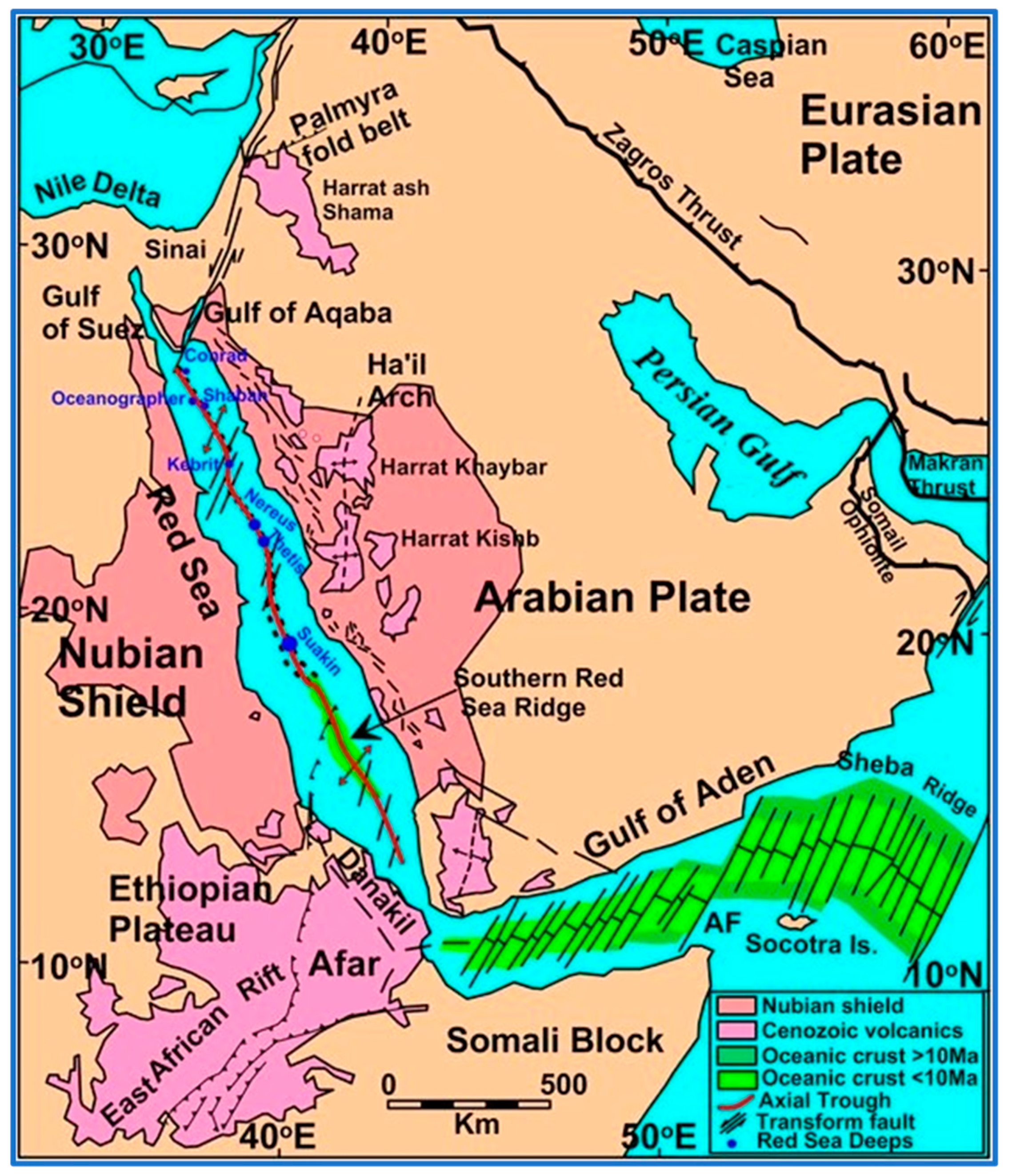
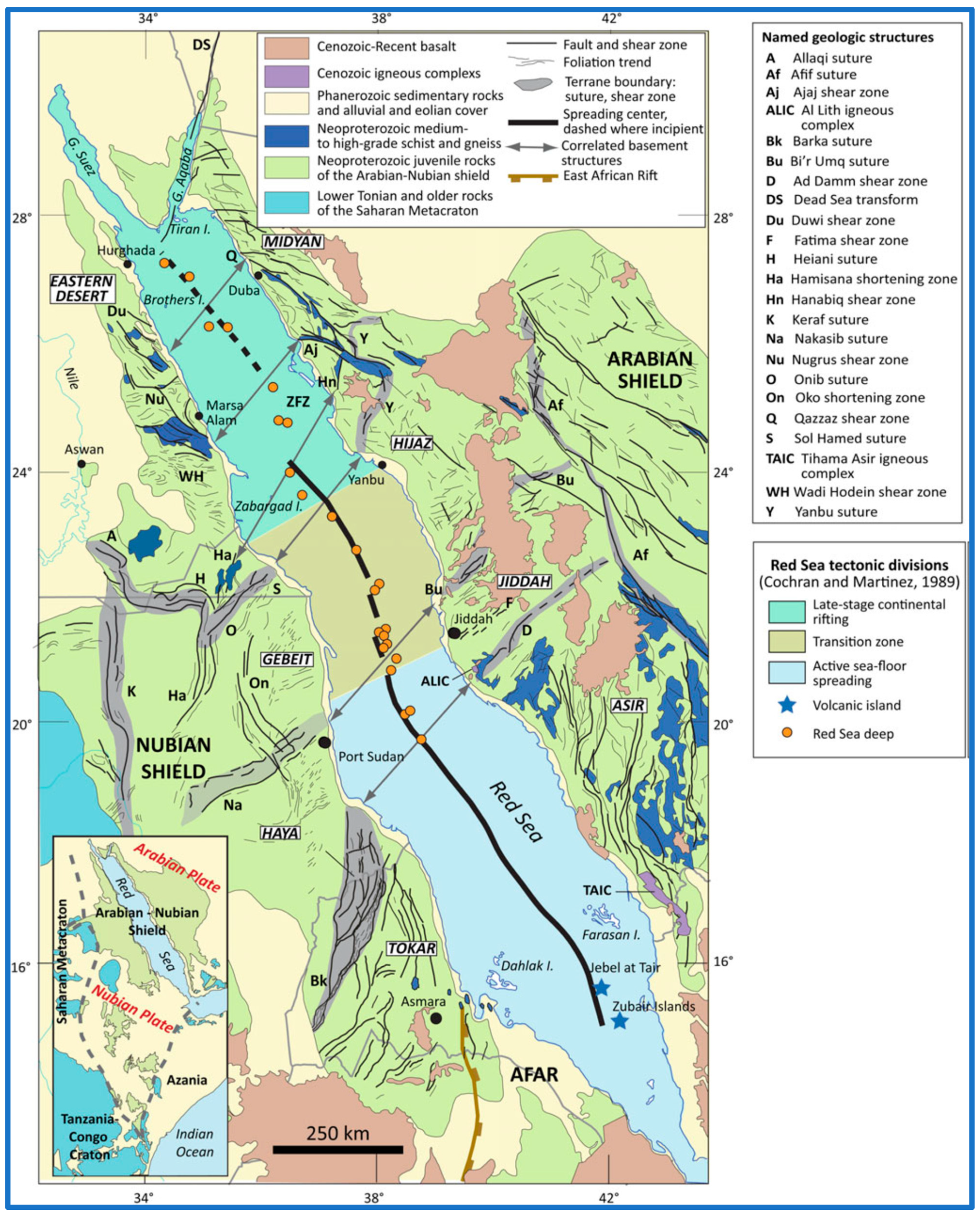
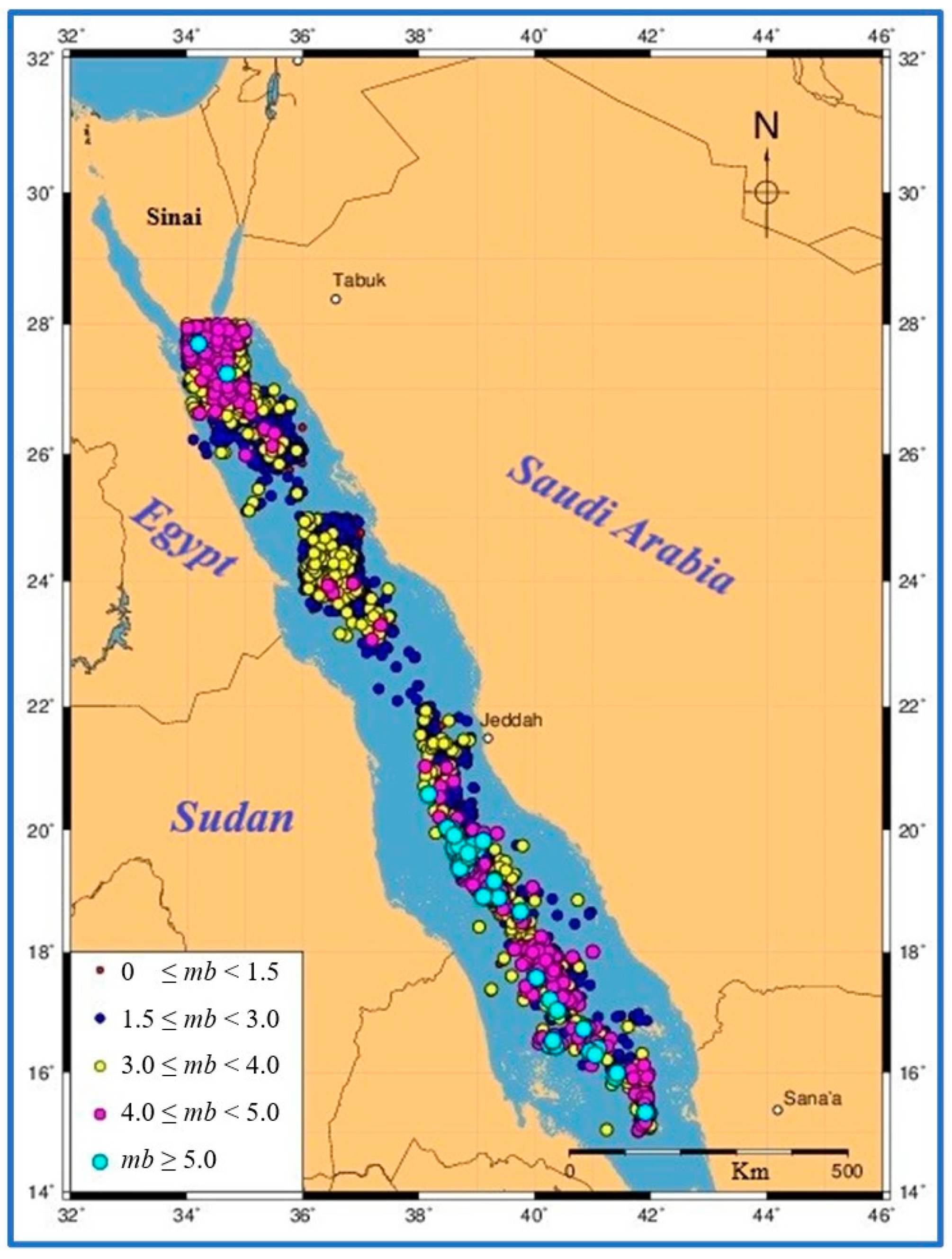
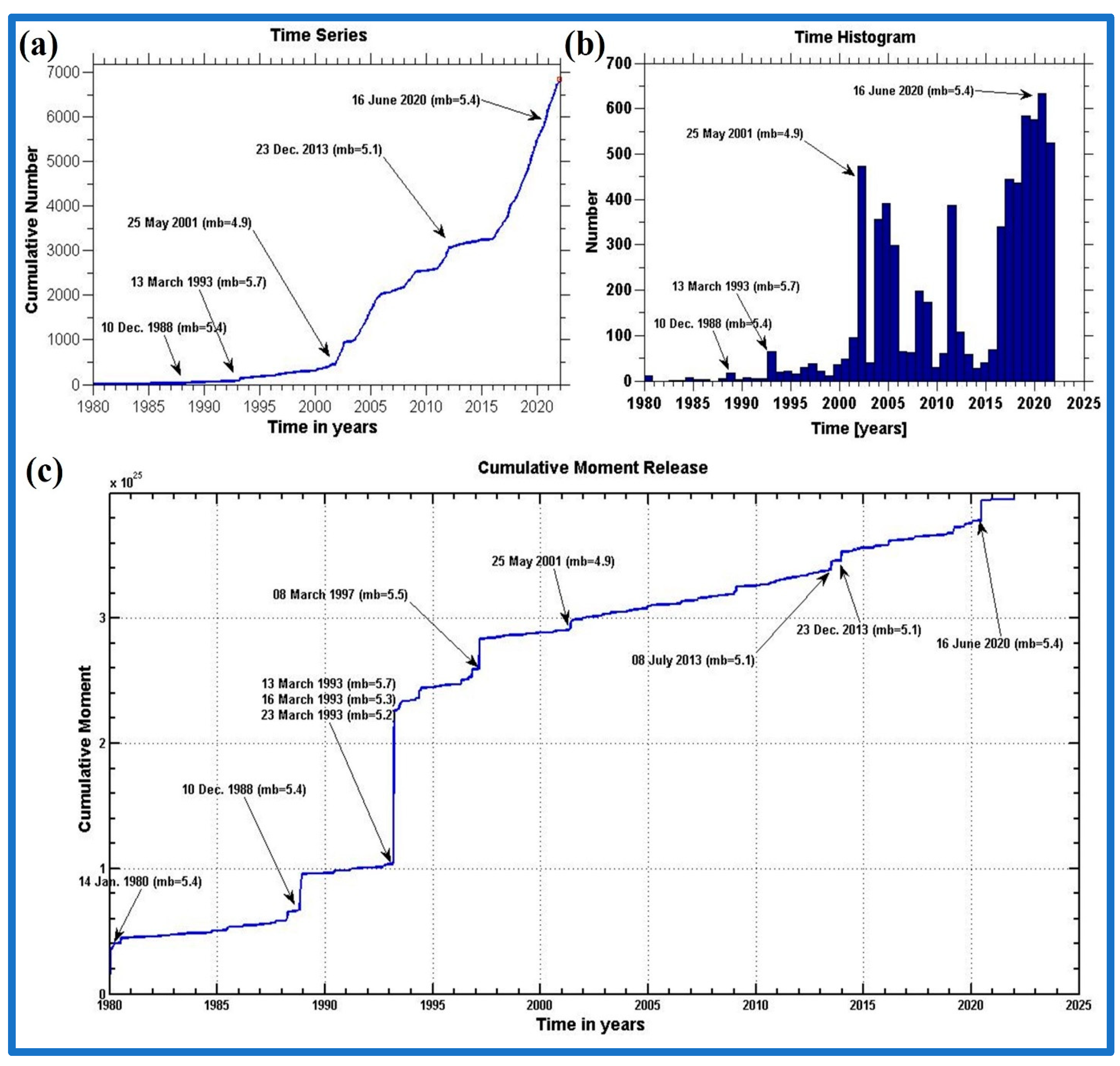
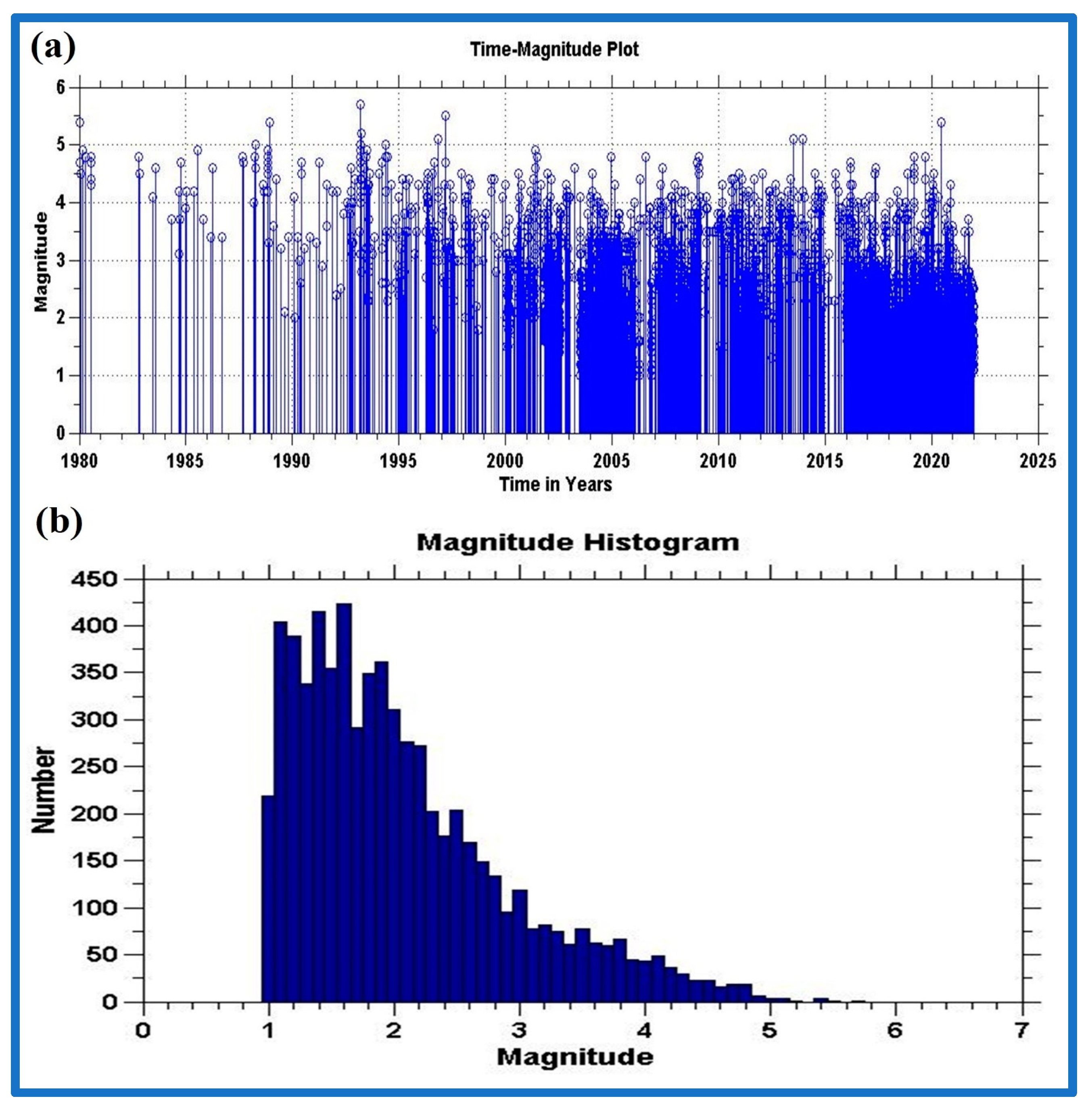
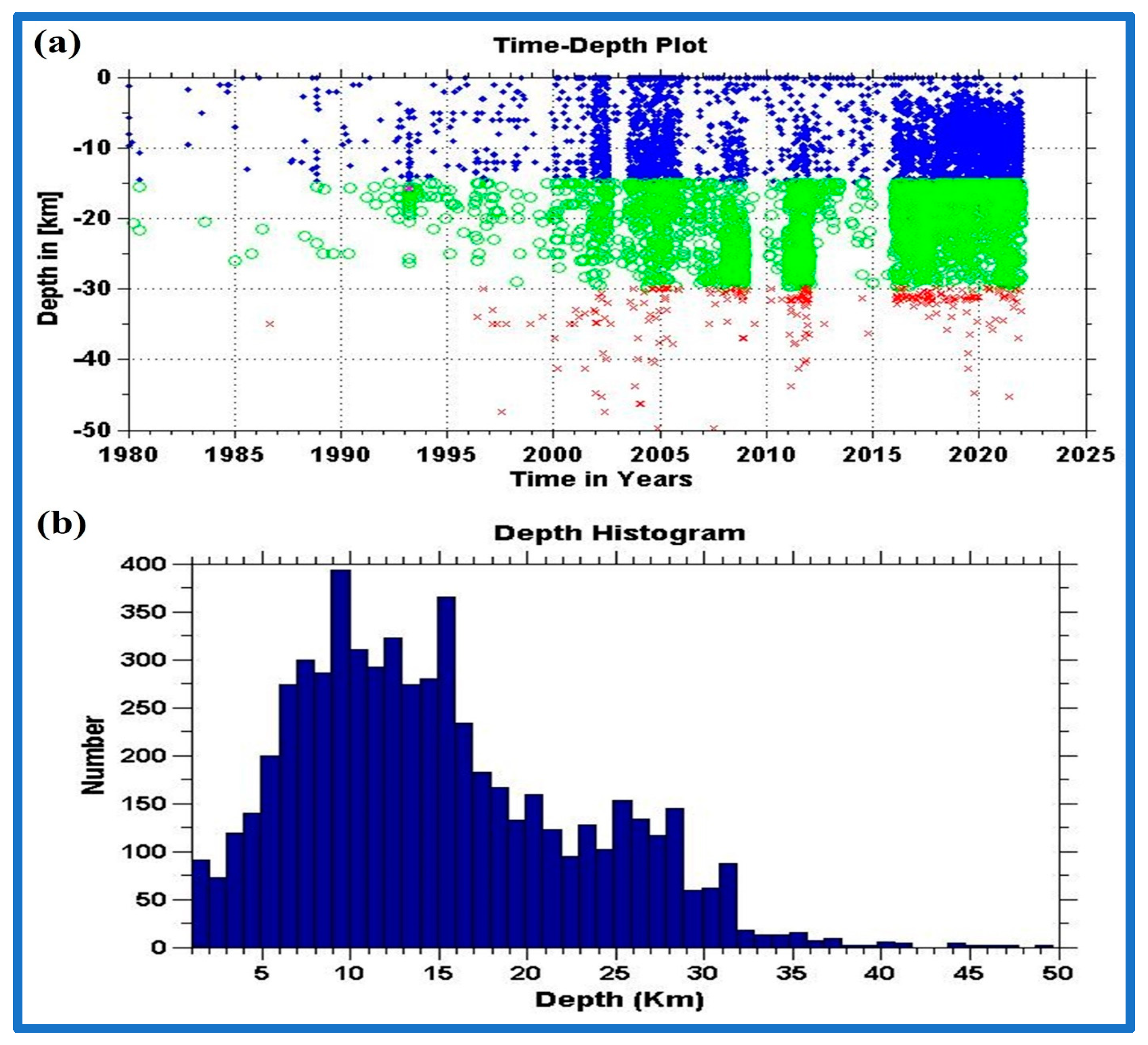


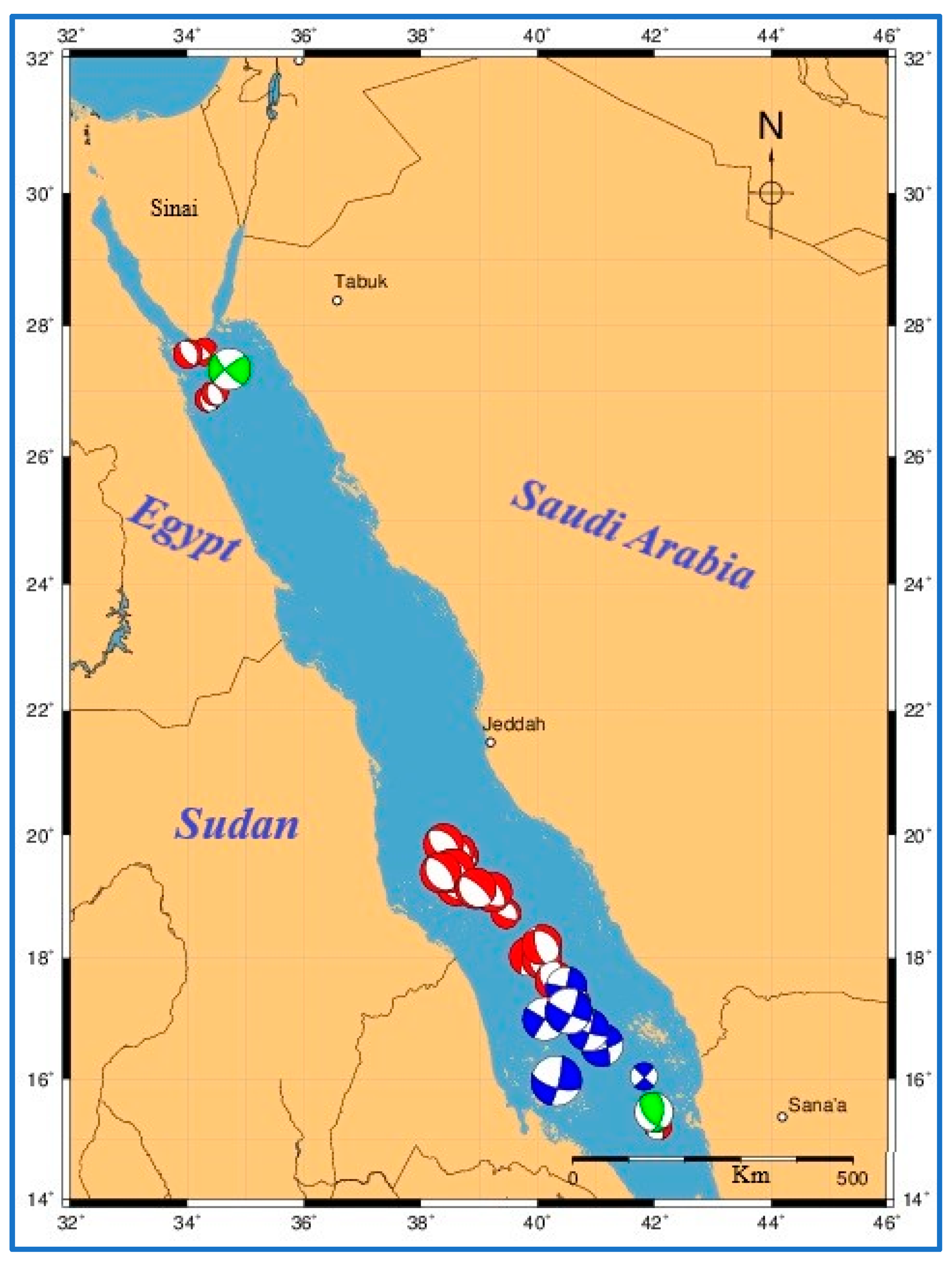


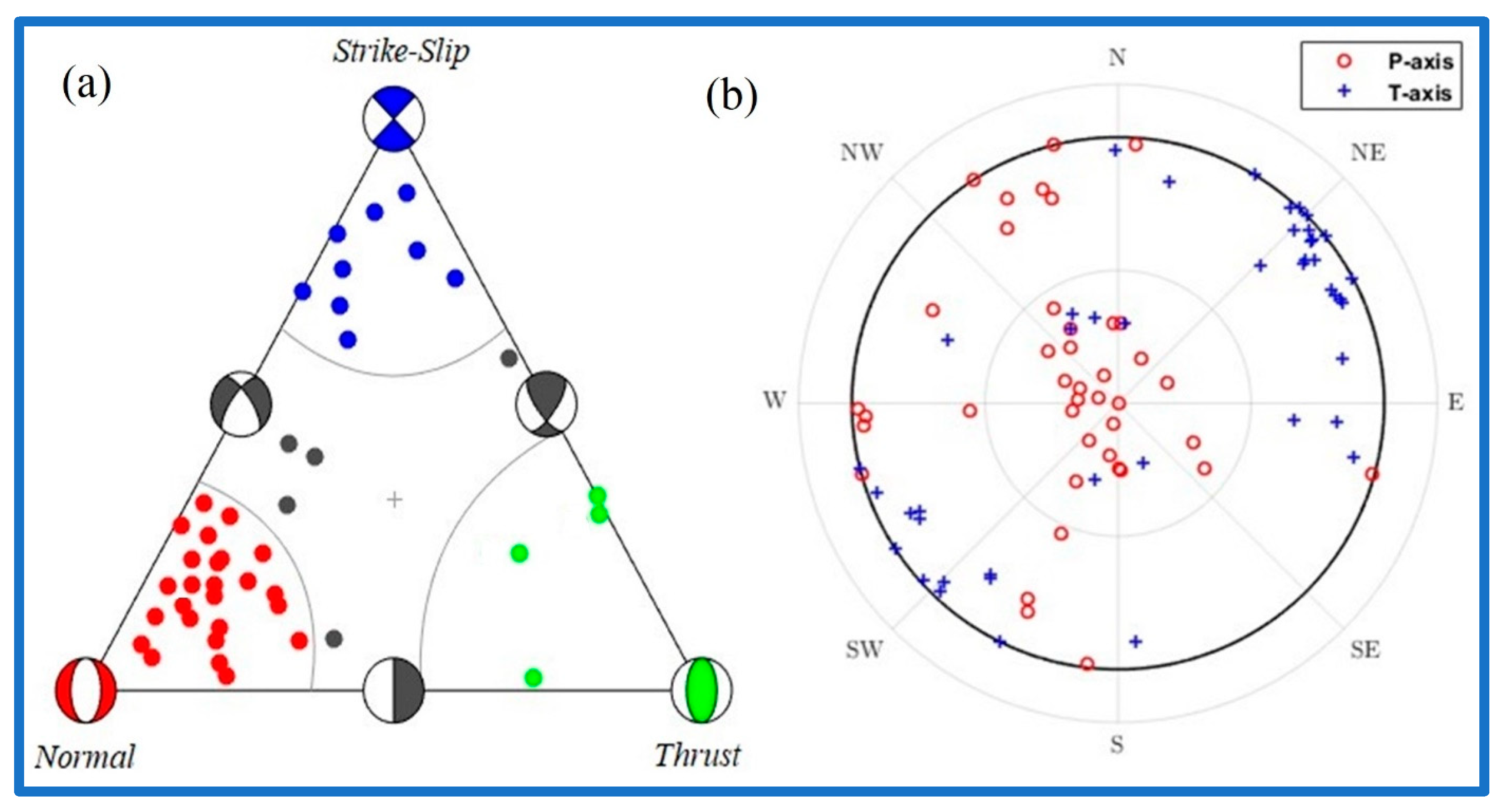
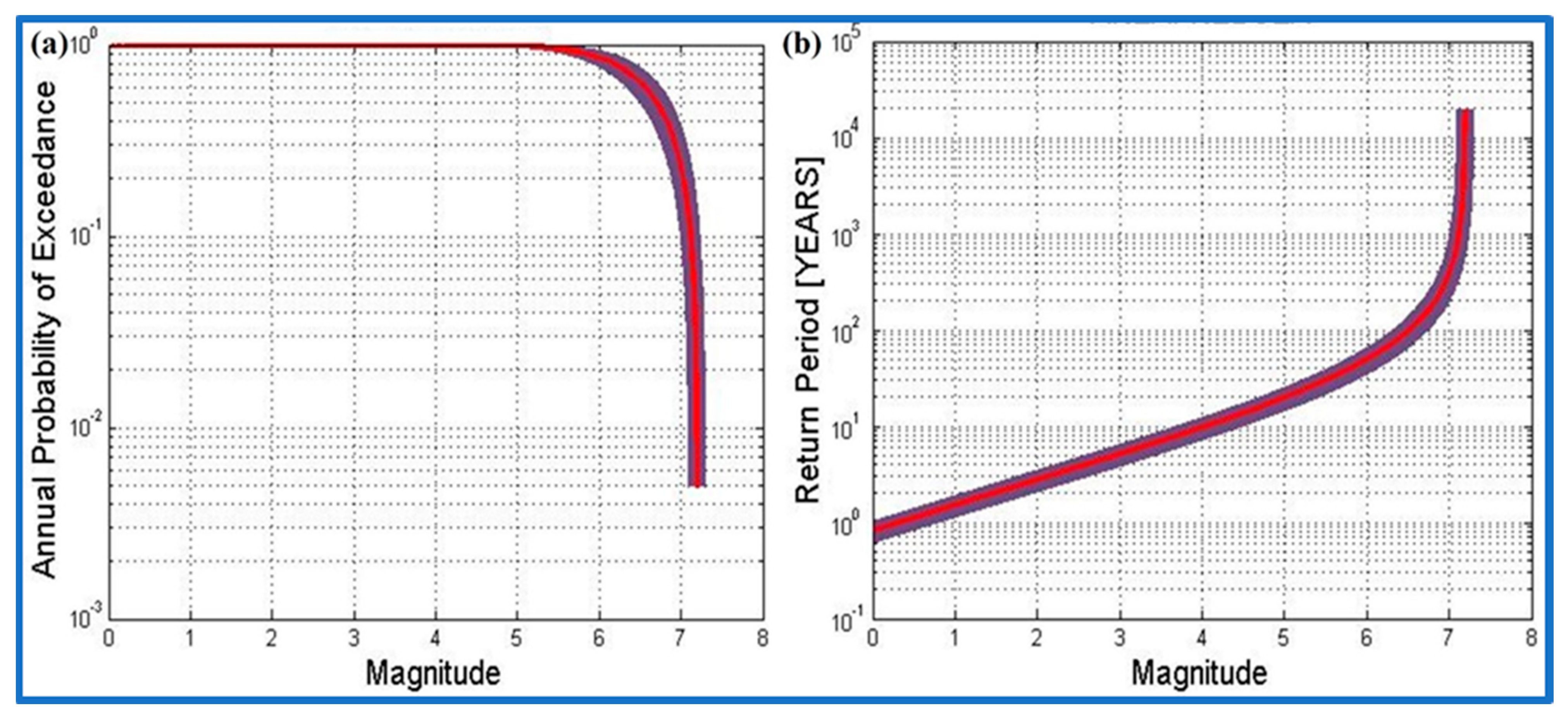
| Magnitude | Return Period | Probability of Exceedance (Years) | |||
|---|---|---|---|---|---|
| 1 | 10 | 50 | 100 | ||
| 4 | 9.70 × 100 | 0.99965 | 1 | 1 | 1 |
| 4.1 | 1.04 × 101 | 0.99947 | 1 | 1 | 1 |
| 4.2 | 1.11 × 101 | 0.99922 | 1 | 1 | 1 |
| 4.3 | 1.19 × 101 | 0.99885 | 1 | 1 | 1 |
| 4.4 | 1.27 × 101 | 0.99834 | 1 | 1 | 1 |
| 4.5 | 1.36 × 101 | 0.99762 | 1 | 1 | 1 |
| 4.6 | 1.46 × 101 | 0.99662 | 1 | 1 | 1 |
| 4.7 | 1.57 × 101 | 0.99527 | 1 | 1 | 1 |
| 4.8 | 1.69 × 101 | 0.99346 | 1 | 1 | 1 |
| 4.9 | 1.82 × 101 | 0.99104 | 1 | 1 | 1 |
| 5 | 1.97 × 101 | 0.98787 | 1 | 1 | 1 |
| 5.1 | 2.13 × 101 | 0.98375 | 1 | 1 | 1 |
| 5.2 | 2.31 × 101 | 0.97845 | 1 | 1 | 1 |
| 5.3 | 2.50 × 101 | 0.97172 | 1 | 1 | 1 |
| 5.4 | 2.73 × 101 | 0.96325 | 1 | 1 | 1 |
| 5.5 | 2.97 × 101 | 0.95271 | 1 | 1 | 1 |
| 5.6 | 3.26 × 101 | 0.93971 | 1 | 1 | 1 |
| 5.7 | 3.58 × 101 | 0.92384 | 1 | 1 | 1 |
| 5.8 | 3.95 × 101 | 0.90466 | 1 | 1 | 1 |
| 5.9 | 4.38 × 101 | 0.88166 | 1 | 1 | 1 |
| 6 | 4.88 × 101 | 0.85436 | 1 | 1 | 1 |
| 6.1 | 5.48 × 101 | 0.8222 | 0.99999 | 1 | 1 |
| 6.2 | 6.20 × 101 | 0.78466 | 0.99999 | 1 | 1 |
| 6.3 | 7.09 × 101 | 0.74117 | 0.99996 | 1 | 1 |
| 6.4 | 8.20 × 101 | 0.6912 | 0.99988 | 1 | 1 |
| 6.5 | 9.63 × 101 | 0.63419 | 0.99966 | 1 | 1 |
| 6.6 | 1.16 × 102 | 0.56965 | 0.99901 | 1 | 1 |
| 6.7 | 1.42 × 102 | 0.49708 | 0.99704 | 1 | 1 |
| 6.8 | 1.83 × 102 | 0.41603 | 0.99095 | 1 | 1 |
| 6.9 | 2.50 × 102 | 0.32611 | 0.97176 | 1 | 1 |
| 7 | 3.85 × 102 | 0.22698 | 0.90975 | 0.99993 | 1 |
| 7.1 | 7.91 × 102 | 0.11835 | 0.70391 | 0.99515 | 0.99991 |
Disclaimer/Publisher’s Note: The statements, opinions and data contained in all publications are solely those of the individual author(s) and contributor(s) and not of MDPI and/or the editor(s). MDPI and/or the editor(s) disclaim responsibility for any injury to people or property resulting from any ideas, methods, instructions or products referred to in the content. |
© 2023 by the authors. Licensee MDPI, Basel, Switzerland. This article is an open access article distributed under the terms and conditions of the Creative Commons Attribution (CC BY) license (https://creativecommons.org/licenses/by/4.0/).
Share and Cite
Ali, S.M.; Abdelrahman, K. The Impact of Fractal Dimension, Stress Tensors, and Earthquake Probabilities on Seismotectonic Characterisation in the Red Sea. Fractal Fract. 2023, 7, 658. https://doi.org/10.3390/fractalfract7090658
Ali SM, Abdelrahman K. The Impact of Fractal Dimension, Stress Tensors, and Earthquake Probabilities on Seismotectonic Characterisation in the Red Sea. Fractal and Fractional. 2023; 7(9):658. https://doi.org/10.3390/fractalfract7090658
Chicago/Turabian StyleAli, Sherif M., and Kamal Abdelrahman. 2023. "The Impact of Fractal Dimension, Stress Tensors, and Earthquake Probabilities on Seismotectonic Characterisation in the Red Sea" Fractal and Fractional 7, no. 9: 658. https://doi.org/10.3390/fractalfract7090658
APA StyleAli, S. M., & Abdelrahman, K. (2023). The Impact of Fractal Dimension, Stress Tensors, and Earthquake Probabilities on Seismotectonic Characterisation in the Red Sea. Fractal and Fractional, 7(9), 658. https://doi.org/10.3390/fractalfract7090658








